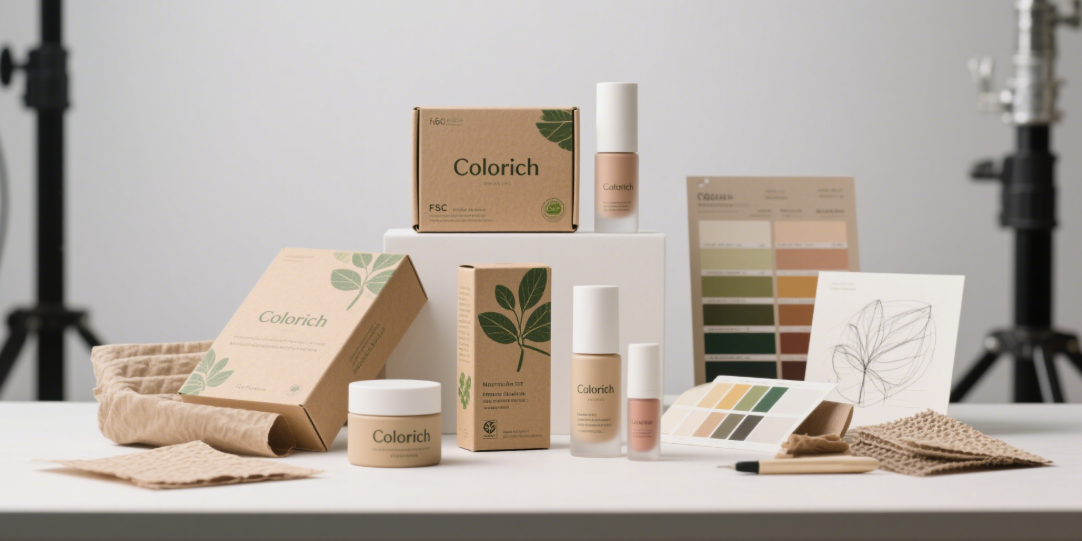As sustainability becomes a cornerstone of consumer decision-making, businesses across industries are prioritizing eco-friendly packaging to reduce environmental impact. In 2025, the demand for sustainable packaging solutions is at an all-time high, driven by consumer awareness, regulatory pressures, and advancements in material science. For industries like cosmetics, where packaging plays a critical role in both functionality and brand appeal, the challenge is to balance environmental responsibility with aesthetic and practical requirements. This comprehensive guide explores the most environmentally friendly packaging options for 2025, with a focus on the cosmetics industry, and provides actionable insights for brands aiming to adopt sustainable practices.

The environmental impact of packaging waste is staggering. Global packaging waste is projected to reach 380 million tons annually by 2025, with plastics accounting for a significant portion, according to recent industry reports. In the cosmetics industry, where packaging is often single-use and complex (e.g., pumps, jars, and tubes), the need for sustainable alternatives is urgent. A 2024 NielsenIQ survey found that 73% of global consumers would switch brands for more sustainable packaging. Additionally, regulations like the EU’s Packaging and Packaging Waste Regulation (PPWR) are pushing brands to adopt recyclable, reusable, or compostable materials by 2030.
At Colorich, we believe that beauty shouldn't come at the cost of the planet. Our commitment to eco-friendly packaging involves using FSC-certified paper, biodegradable inks, and recyclable structures that maintain the luxury and functionality beauty brands expect. By researching materials that balance sustainability with shelf appeal, we help our clients stand out responsibly. This article dives into the top eco friendly cosmetic packaging options for 2025, their benefits, challenges, and how they align with the cosmetics industry’s unique needs.
What Are They?
Biodegradable and compostable materials break down naturally in the environment, reducing landfill waste. Common options include:
Mushroom Packaging: Made from mycelium and agricultural waste, this material is fully compostable and customizable for cosmetics packaging.
PLA (Polylactic Acid): Derived from renewable resources like corn starch, PLA is compostable in industrial facilities and suitable for bottles and jars.
Bagasse: A byproduct of sugarcane processing, bagasse is used for rigid, compostable containers.
Bamboo: A fast-growing, renewable resource used for jars, compacts, and outer packaging.
Benefits:
Decomposes naturally, minimizing environmental footprint.
Appeals to eco-conscious consumers, a key driver in cosmetics purchasing decisions.
Aligns with circular economy principles by returning nutrients to the soil.
Challenges:
Limited industrial composting infrastructure in some regions.
Higher production costs compared to traditional plastics.
May require consumer education for proper disposal.
Cosmetics Application:
Colorich uses biodegradable inks and compostable structures in our packaging solutions, ensuring that beauty brands can offer eco-friendly products without sacrificing premium aesthetics. For example, PLA-based lipstick tubes and bamboo compacts provide a luxurious feel while being compostable.

2025 Trend:
Innovations in enzyme-based biodegradable plastics are improving durability and reducing costs. Companies like Novamont are leading the way, and by 2025, compostable packaging is expected to gain traction in mainstream cosmetics brands.
What Are They?
Recyclable materials, such as glass, aluminum, and certain plastics (e.g., PET, HDPE), can be processed and reused in new products. Advancements in recycling technologies are making these materials even more sustainable in 2025.
Benefits:
Reduces demand for virgin materials.
Well-established recycling infrastructure in many regions.
Glass and aluminum offer a premium look, ideal for high-end cosmetics.
Challenges:
Not all plastics are recyclable in practice due to contamination or mixed materials.
Global recycling rates remain low (e.g., only 9% of plastic waste is recycled, per OECD data).
Energy-intensive recycling processes for some materials.
2025 Trend:
Chemical recycling, which breaks plastics down to their molecular components, is gaining momentum. This technology enables infinite recycling of plastics like PET, making it a game-changer for cosmetics packaging.
What Are They?
Reusable packaging involves durable containers that consumers can refill with product, reducing single-use waste. Examples include:
Refillable Compacts: Metal or glass compacts for powders and foundations.
Refill Pouches: Flexible pouches for liquids like shampoos or lotions.
Modular Systems: Interchangeable components for multi-use packaging.
Benefits:
Extends the lifecycle of packaging, reducing waste.
Encourages brand loyalty through refill programs.
Premium designs enhance consumer perception.
Challenges:
Higher upfront costs for durable materials.
Requires consumer participation in refill programs.
Logistical challenges for brands managing refill systems.
2025 Trend:
Smart packaging with QR codes and IoT integration will streamline refill programs, allowing consumers to track usage and order refills seamlessly.
What Are They?
PCR materials are made from recycled consumer waste, such as plastic bottles or paper products. Common PCR materials include rPET (recycled PET) and recycled cardboard.
Benefits:
Reduces demand for virgin resources.
Lowers carbon footprint compared to new materials.
Widely accepted by consumers and regulators.
Challenges:
Limited availability of high-quality PCR materials.
Potential aesthetic limitations for luxury brands.
Contamination risks in recycling streams.
2025 Trend:
Closed-loop recycling systems, where brands collect and recycle their own packaging, will boost PCR adoption in cosmetics.
What Are They?
Paper-based packaging, such as FSC-certified cardboard and molded pulp, is renewable, recyclable, and often biodegradable. It’s ideal for secondary packaging (e.g., boxes) and some primary packaging (e.g., compacts).
Benefits:
Renewable and widely recyclable.
Lightweight, reducing transportation emissions.
Customizable for premium branding.
Challenges:
Limited water resistance for certain applications.
May require coatings, which can reduce recyclability.
Higher costs for FSC-certified options.
Cosmetics Application:
Colorich's FSC-certified paper packaging is designed for beauty brands seeking eco-friendly secondary packaging. Our biodegradable inks ensure that the entire package is sustainable, from printing to disposal.
2025 Trend:
Innovations in water-resistant paper coatings will expand the use of paper-based packaging for primary cosmetics packaging, such as tubes and jars.
| Material | Sustainability | Cost | Aesthetics | Cosmetics Suitability |
|---|---|---|---|---|
| Biodegradable/Compostable | High (decomposes naturally) | High | Moderate to High | Lipsticks, compacts, jars |
| Recyclable (Glass/Aluminum) | High (widely recycled) | Moderate | High | Jars, bottles, compacts |
| Reusable/Refillable | High (extends lifecycle) | High | High | Foundations, lipsticks |
| PCR Materials | High (uses recycled waste) | Moderate | Moderate | Tubes, bottles |
| Paper-Based | High (renewable, recyclable) | Low to Moderate | Moderate to High | Boxes, compacts |
Refillable packaging emerges as the most environmentally friendly option for 2025, particularly for the cosmetics industry. By extending the lifecycle of packaging and reducing single-use waste, refillable systems align with circular economy principles and consumer demand for sustainable solutions. When paired with biodegradable or recyclable materials (e.g., glass or bamboo), refillable packaging minimizes environmental impact while maintaining the premium aesthetic that beauty brands require.
Cost: Sustainable materials often have higher upfront costs, though long-term savings can be achieved through consumer loyalty and regulatory compliance.
Infrastructure: Recycling and composting facilities vary by region, affecting the real-world sustainability of certain materials.
Consumer Behavior: Educating consumers on proper disposal and refill processes is critical for success.
Regulatory Compliance: Brands must navigate evolving regulations, such as the EU’s PPWR, which mandates recyclable or compostable packaging by 2030.
At Colorich, sustainability is at the core of our mission. We partner with beauty brands to create packaging that balances environmental responsibility with functionality and aesthetics. Our key strategies include:
FSC-Certified Paper: Sourced from responsibly managed forests to reduce deforestation.
Biodegradable Inks: Non-toxic and compostable, ensuring eco-friendly printing.
Recyclable Structures: Designed for easy integration into existing recycling streams.
Research and Innovation: Continuously exploring new materials, like enzyme-based biodegradable plastics, to stay ahead of 2025 trends.
By combining these elements, we help brands meet consumer demand for sustainability while maintaining the premium look and feel that defines the cosmetics industry.
Refillable packaging, particularly when made from recyclable or biodegradable materials like glass, bamboo, or PLA, is the most sustainable option for 2025. It reduces single-use waste and aligns with circular economy principles.
Brands can adopt refillable systems, use PCR materials, and prioritize recyclable or compostable packaging. Partnering with companies like Colorich ensures access to sustainable beauty packaging solutions tailored to cosmetics.
Biodegradable plastics, like PLA, are eco-friendly when composted in industrial facilities. However, their sustainability depends on proper disposal and local composting infrastructure.
FSC-certified paper comes from responsibly managed forests, reducing deforestation and ensuring recyclability. It’s ideal for secondary packaging in cosmetics, offering both sustainability and premium aesthetics.
Refillable systems use durable containers (e.g., glass or metal) that consumers can replenish with product refills, often sold in pouches or cartridges. This reduces waste and enhances brand loyalty.
In 2025, refillable packaging stands out as the most environmentally friendly option for cosmetics and beyond, followed closely by recyclable glass and aluminum and PCR materials. These solutions balance sustainability, functionality, and consumer appeal, making them ideal for beauty brands aiming to reduce their environmental footprint. At Colorich, we're committed to helping brands navigate this transition with innovative, eco-friendly packaging that doesn't compromise on luxury or performance. By adopting sustainable materials and staying ahead of trends like chemical recycling and smart packaging, brands can lead the way in sustainability while captivating eco-conscious consumers.
For more information on sustainable packaging solutions, visit Colorich or explore the latest industry trends to make informed decisions for your brand.

Hey,I'm Rachel Liao,the sales manager of Colorich Packaging.
With solid professional skills and acute market insight, focus on providing customers with customized packaging solutions and supply chain optimization services.
●Packaging demand analysis and solution design
●Customer development and long-term relationship maintenance
●Cost optimization and sustainable packaging practices
